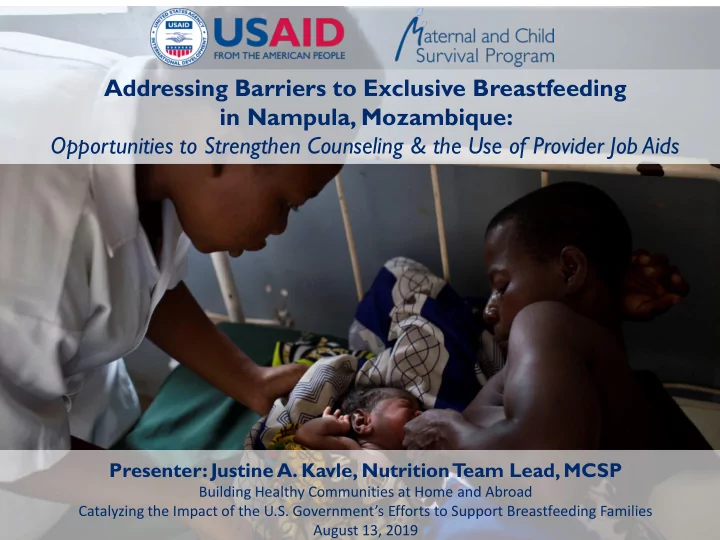

Addressing Barriers to Exclusive Breastfeeding in Nampula, Mozambique: Opportunities to Strengthen Counseling & the Use of Provider Job Aids Presenter: Justine A. Kavle, Nutrition T eam Lead, MCSP Building Healthy Communities at Home and Abroad Catalyzing the Impact of the U.S. Government’s Efforts to Support Breastfeeding Families August 13, 2019
Slow progress in exclusive breastfeeding (EBF) Evidence needed on how to strengthen provider competencies Progress slow in achieving 2025 & 2030 extended targets WHO, 2018 & FAO, IFAD, UNICEF, WFP, and WHO. 2019.
Objectives of Implementation Science Study 1. Identify problems and challenges with EBF experienced by mothers in Nampula, Mozambique. 2. Better understand mothers’ care -seeking patterns for addressing breastfeeding problems and challenges. 3. Assess the quality and type of counseling on breastfeeding problems and challenges provided by facility and community-based health providers. 4. Assess the usefulness of job aids to improve counseling on barriers to EBF.
Phase 1 Findings: Common problems that impede EBF: insufficient breastmilk • Mothers and community-based health providers believe that during the first two days, some mothers do not produce any breastmilk. [During the first two days after the baby was born] I breastfed anyway, he sucked and did not find anything until the next day that the milk began to come out. – Mother, Mogovolas In the first days, they have been having many difficulties, because some mothers spend two days without breastmilk coming out. – Community-based provider, Mogovolas
Phase 1 Findings: Common problems that impede EBF In the first days of life: • Latching problems (improper latch, positioning, and sore nipples), & breast engorgement were key barriers. The majority of mothers have problems in the first days after giving birth at the beginning of breastfeeding (...) there have been mothers who have a swollen breast and this causes pain because the baby cannot suck all the milk (...) there are other women who have cracked nipple problems. – Community-based health provider, Meconta
Phase 1 Findings: Common problems that impede EBF: insufficient breastmilk • Concerns about insufficient milk until 3-4 months of age caregiver perceives infant is thirsty and hungry & offers porridge/water. • Improving maternal diet was the most important strategy for managing insufficient breastmilk, according to health providers and mothers. Some say, “my baby is nursing a lot, he is hungry, he gets weak, so to avoid it I have to give my son something because then he goes to sleep, he fills up and I can stay an hour or two without the baby waking up .” – Facility-based provider, Mogovolas
Phase 1 Findings : Mothers’ sources of support for breastfeeding 1 st source of support 2 nd source of support Husband 3 rd source of support Parents, other family Referral Health Community- Mother facility based provider
Phase 1: EBF counseling & support at routine contacts is limited Community level: CHWs Community level : Facility level: refer most BF problems to the • Provider counseling on Little counseling to health facility – lack of self- BF positioning and skin- help prepare women efficacy & training to-skin for BF challenges Facility level: Group BF • Lack of self-efficacy in promotion talks but individual Facility level : Group counseling on counseling not provided unless talks covered broad importance of colostrum infant weight-gain issues are topics, seldom BF and early initiation identified Childbirth Pregnancy Postnatal/child visits
Phase 2: Development of 3 job aids
Provider Job Aids: Maternity, child health visits, and community level Flowchart format: 1. Observe breastfeeding and ensure good latch and positioning. 2. Discuss responsive feeding and how to maintain milk supply. 3. How to manage a variety of BF problems. 4. How to counsel on BF problems before referring to a health facility (community provider) 10
Phase 3 Findings: Job aid use • Facility- and community-based providers incorporated job aids into individual and group counseling. • Providers showed the job aid images to the women they counseled, aiding provider explanation and mothers’ comprehension. • Job aids used to identify, resolve, and prevent breastfeeding problems
Phase 3 Findings: Job aid impact: provider knowledge
Phase 3 Findings: Job aids facilitated provision of counseling & practical support Phase 3: Post-Job Aid Phase 1: Pre-Job Aid I only know how to give To demonstrate the latch… I watch each mother the mother a talk to give and see how the baby is doing the suction. I say, breast milk until 6 ‘this is correct’, if not I say, ‘you are breastfeeding, months, those but it does not have to be in this way, it has to be techniques to get this way.’ And also the mothers see those images attached to the breast I [in the job aid], because first I have to do the talk did not know. with the job aid, then execute what is in the job aid. - Facility-based provider, – Facility-based provider, Mogovolas Mogovolas
Phase 3 Findings: Job aids increased provider motivation & self-efficacy Phase 1: Pre-Job Aid Phase 3: Post-Job Aid I did not give much advice I Now that I have this material that is cannot lie, nor explained what to very good, the information that I give is eat and how to breastfeed accurate (…) Now with this material, because we did not learn, I only we talk and the mother can see the gave advice to the mother of images that correspond to what we what I was trained. speak. (…) People used to hardly accept [our advice], but not today. – Community-based provider, Meconta – Community-based provider, Meconta
Programmatic Implications Job aids can build providers’ skillsets and • competencies to provide high-quality lactation support and counseling. • Integrate clear lactation management guidance into pre- and in-service curricula & supportive supervision. Validate/roll out job aids to complement • existing infant and young child feeding counseling materials & Baby Friendly Hospital Initiative. • Task-shift to community-level providers for comprehensive breastfeeding support.
Thank you! Obrigada!
Recommend
More recommend